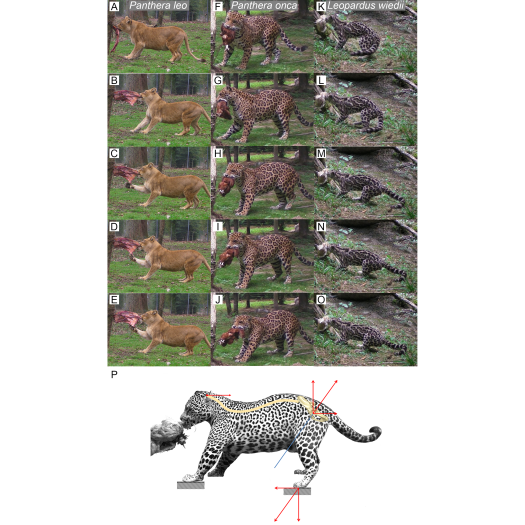Variation in the sacroiliac joint in Felidae

Figure 5: Functional hypothesis of forces transmission through hind limbs when felids pull on food.

Figure 5: Functional hypothesis of forces transmission through hind limbs when felids pull on food.
Article paru le 11 mai dans PeerJ et tiré de la thèse de Jean-Pierre Pallandre ex doctorant ISYEB
Pallandre, J.-P., Lavenne, F., Pellé, E., Breton, G., Ribaud, M., & Bels, V. (2021). Variation in the sacroiliac joint in Felidae. PeerJ, 9, e11116. https://doi.org/10.7717/peerj.11116
L’articulation entre l’ilium et le sacrum des félins est soumises à de très fortes contraintes fonctionnelles dues aux différents comportements exécutés par ces prédateurs. Le comportement de prédation influence de manière significative la position relative des ailes iliaques gauche et droite en optimisant la stabilité des félins pour tuer et déchirer des proies dont la masse est égale ou supérieure à la leur.
–—
ABSTRACT
Felidae species show a great diversity in their diet, foraging and hunting strategies, from small to large prey. Whether they belong to solitary or group hunters, the behavior of cats to subdue resisting small or large prey presents crucial differences. It is assumed that pack hunting reduces the per capita risk of each individual. We hypothesize that the sacroiliac articulation plays a key role in stabilizing the predator while subduing and killing prey. Using CT-scan from 59 felid coxal bones, we calculated the angle between both iliac articular surfaces. Correlation of this inter-iliac angle with body size was calculated and ecological stressors were evaluated on inter-iliac angle. Body size significantly influences inter-iliac angle with small cats having a wider angle than big cats. Arboreal species have a significantly larger angle compared to cursorial felids with the smallest value, and to scansorial and terrestrial species with intermediate angles. Felids hunting large prey have a smaller angle than felids hunting small and mixed prey. Within the Panthera lineage, pack hunters (lions) have a larger angle than all other species using solitary hunting strategy. According to the inter-iliac angle, two main groups of felids are determined: (i) predators with an angle of around 40° include small cats (i.e., Felis silvestris, Leopardus wiedii, Leptailurus serval, Lynx Canadensis, L. rufus; median = 43.45°), the only pack-hunting species (i.e., Panthera leo; median = 37.90°), and arboreal cats (i.e., L. wiedii, Neofelis nebulosa; median = 49.05°), (ii) predators with an angle of around 30° include solitary-hunting big cats (i.e., Acinonyx jubatus, P. onca, P. pardus, P. tigris, P. uncia; median = 31.80°). We suggest different pressures of selection to interpret these results. The tightening of the iliac wings around the sacrum probably enhances big cats’ ability for high speed and large prey control. In contrast, pack hunting in lions reduced the selective pressure for large prey.